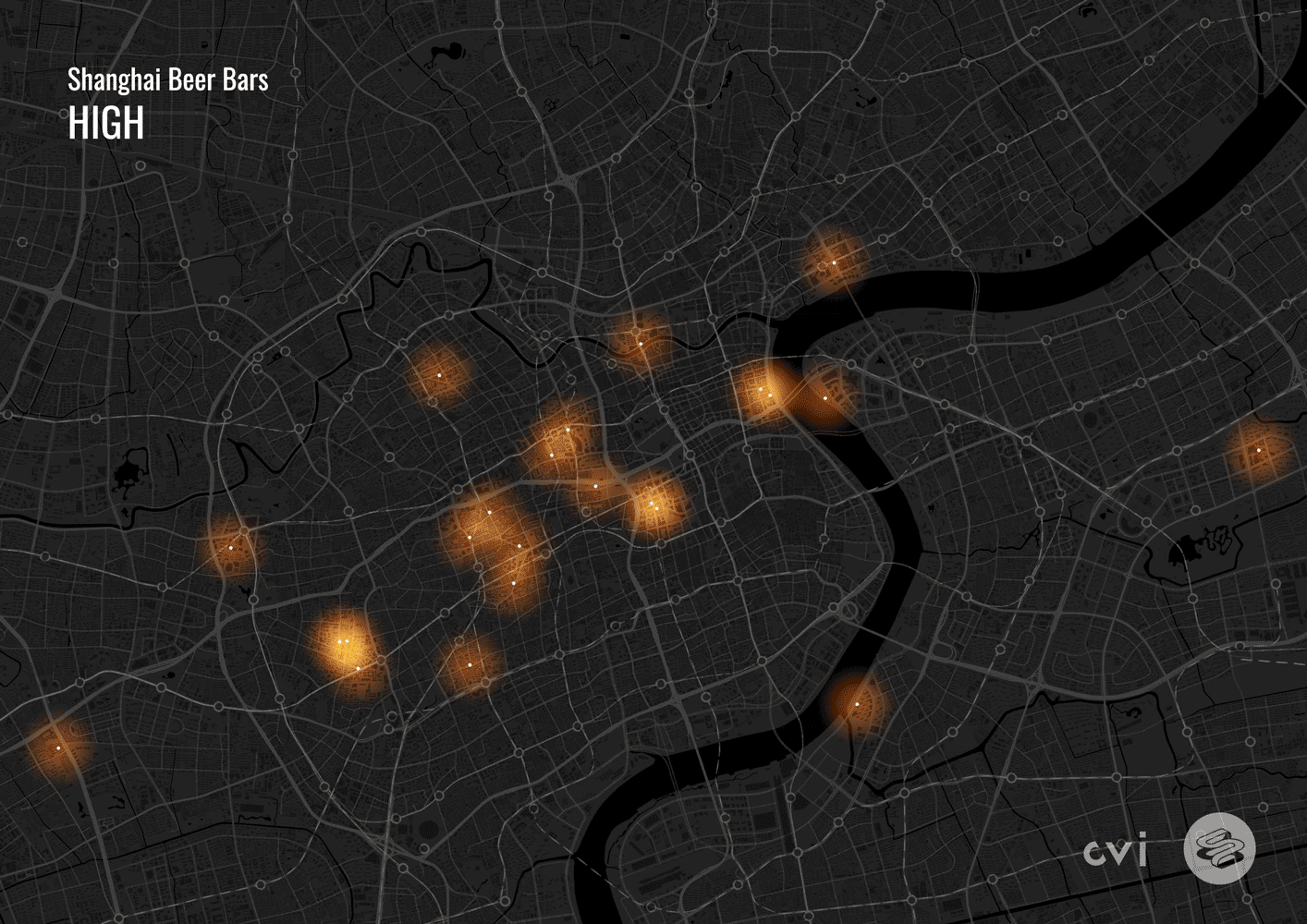Money's tight, but we still need to drink.
So, I went to bars. I went to a lot of bars. I visited 41 bars in five belchy days to find out what their cheapest draft beer was. I actually visited more to confirm if they did or did not have beer on draft (a surprising number don't). This typically involved a process known as "looking at the menu." Draft beer!
For the remaining bars I didn't visit, I reached out to people who either work there or are familiar with their offerings.
All in all, I checked 50 bars to find the cheapest draft beer.
Click to see the full image
I put all my data into a spreadsheet to see what I'd found (click here to download the Excel in its full glory!). Because that's what scientists do, and I'm here to do science, or at least some third-grade math. I divided the price (rmb) by the volume (ml) to reach the golden frothy ratio: price per ml. I calculated to three decimal places because science requires precision.
I also got CVI, an actual analytics company, involved. I asked them to compile all the data from, say, a popular local directory app, pulled the average price from every place tagged with beer (screening out the ones that are plainly tagged wrong), and put them on a heat map. Sneak preview:

Had I drunk every beer I indexed, I would have consumed 57.302 liters of beer and spent 5,478.7rmb. That comes to a 477ml glass of beer costing 45.7rmb, every hour for five days straight. In reality, I only had about ten liters of beer. A piddly two liters of beer per day of research. Rookie numbers, but I'm not 14 years old anymore.
Yeah Yeah Whatever But What's The Cheapest Beer in Shanghai Please
Jiuhuar's Moonlight Belgian Witbier.

You're welcome!
But honestly, of all the things I learned in this exercise, finding the actual, full-on rock-bottom price of BEER was the least interesting. Here's what else I learned!
What Else the Index Has Taught Me About Beer in Shanghai
Jiuhuar and Tap That are too cheap. Outliers. Disqualified. Also, Perry's is actually even cheaper if you order a three liter tower of Budweiser, something you should never do alone. This is a solo drinker's guide, so also disqualified.
The next best place to drink in Shanghai is at a burger chain.
A pint is not a pint except when it's a metric pint.
The cheapest beer at the most expensive place is 3.5 times more expensive than the cheapest beer at the burger chain.
Japan makes China's cheapest (acceptable) beer.
It makes little to no difference, price-wise, if you drink at a soulless corporate chain or at a lovable independent bar.
If you want to drink at a bar, the cheapest acceptable place to do that is a sports bar in Jing'an.
In case you didn't know, don't drink draft beer on the Bund.
So How Did I Pick These Bars?
Craps shoot. Yup! Very scientific. Mostly it was distance from my desk and whatever I could think of. So yeah, highly subjective as to area. With one exception they are all in Huangpu, Jing'an or Xuhui. But I talked to dozens and dozens of them! So, hopefully, I can find some truth in the aggregate.
I'm sure there are more places that should totally be in my spreadsheet, dear reader. Just Cool? Beer Lady? C's? I'm coming for you next. The quest for cheap beer is never over.
What's Wrong with Jiuhuar and Tap That and Perry's, You Snob?
Nothing! They're just so cheap they were messing with my results, and like any good scientist, I eliminated the results that didn't fit my conclusion. Plus, if I can be honest, Jiuhuar and Tap That are a little crap. You know it. I know it. We know why we go.
And if you're ordering 3 liter Budweiser towers at Perry's by yourself, friend, you need help.
Help finishing that tower, that is!
When Is a Pint Not a Pint?
American pints are 16 fluid ounces, or about 473ml. UK pints are about 568ml. Metric pints are 500ml. I discovered that the bartenders at many bars only have a rough idea of what the volume of their glasses are.
So I'll tell you. The vast majority of places in town use metric pints, if they use "pints" at all. American pints are in second place. An outdated system of measurement, but for beer, it feels... right. Much like "that's kilometers away" will never replace "that's miles away," the Imperial system has a rugged, visceral appeal to it.

Out of the all the bars I sampled, 12% used American pints, 56% used metric pints and I didn't find a single place that did British pints.
Disclaimer: Some glass measures are self-reported, some are printed on the bar menus. There is considerable margin for error, but hey, these were the measurements they told me.
Asahi is the Most Common Cheap Draft
Yes, the Japanese draft (brewed in China) was the cheapest beer at ten bars (average: 0.084rmb/ml).

Incidentally, for reference, a 20L keg of Asahi wholesales for about 275rmb, which comes to about 0.014rmb/ml. So the average place still marks the price up about 478%. Hey guys! Running a bar in Shanghai is expensive.
Next is the combined Spanish Estrellas: Damm at three bars (average 0.099rmb/ml) and Galicia at three bars (average 0.090rmb/ml). Carlsberg had four bars (average 0.071rmb/ml), Tsingtao had two (average 0.074rmb/ml) and poor Tiger was in the back, represented at a single bar (0.085rmb/ml).
Yep, Charlie's Has the Cheapest Asahi
Charlie's is a burger chain with a drinking problem. It's not even a bar, and I wasn't going to include it until one night I ended up there at like 2am and found that they serve Asahi for 25rmb for 500ml. That's 0.050rmb per ml, making it by far the cheapest place to drink what I consider an acceptable draft beer of all the bars I sampled. That's what most bars charge for their beers during happy hour.

The Most Expensive Place is Also the Longest-Running
That's right. Paulaner. How does that work? Have they been successful because they are more expensive, needing less customers? Or are they expensive because they're successful, so they demand a premium? And why is the soft pretzel still only 12rmb? They sell all beers for 68rmb for a 300ml glass, which comes to a staggering 0.227rmb per ml, or 354% more than that Asahi at Charlie's. No other bar broke the 0.200rmb/ml barrier. Well done Paulaner!
Indie Local or Corporate Octopus, It's All the Same
Apart from the damage to your value system, nothing adverse is going to happen to your wallet if you choose corporate draft beer over the local brewery, or vice versa. There's no real price advantage for the customer either way. It's not really cheaper to drink local. Made-in-China bars like Brew Bear, Commune Reserve and Boxing Cat Brewery are priced similarly to foreign outposts.
If You Want an Actual Bar, and Not a Burger Joint
If you absolutely need a wooden counter-top and a pool table to lean your beer on, it's the The Shed! Love it, hate it, both it, the Aussie man-cave sells draft Carlsberg for 0.070rmb/ml (or 30rmb for a 500ml pint). Although, for the same price, you could also drink Tsingtao at Blarney Stone (currently subbing in for Carlsberg) or Stella Artois at Cheer's 1088.
Don't Drink Draft Beer on the Bund, Duh
Because it costs 55rmb for 330ml. Comes to a solid 0.167rmb/ml. Nowhere near as bad bad Paulaner, but yeah, this just confirms what we already knew, which is that the once cheapo student dive at the top of the Bund hostel is no longer for cheapo students! At least the convenience store is still open downstairs.
What If I Don't Want a Lager?
By style, it goes: Tap House has the cheapest ale (Tap House Blond Ale: 50rmb for 450ml). If you want the cheapest IPA, and assuming you're not in for Jiuhuar's 19.9rmb Old Driver (tssst, Jiuhuar, get lost, scram!), it's a tie between Shanghai Love IPA (45rmb for 473ml at Perch) and Boxing Cat Brewery (50rmb for 500ml). The cheapest German wheat beer I could find was at Lenbach, a new spot that does their own stuff. They charge a measly 0.076rmb/ml. I haven't tried it but I can only assume it's worth every fraction of a mao.

The Cheapest Micro-Neighborhood
Shanghai has actual districts, but everyone knows there's Xuhui and then there's Xuhui. A bar on Hengshan Lu or its tributaries might as well be in Minhang if you started your night drinking on the Fumin Lu Triangle. So I broke the locations down into a couple of ad hoc clusters. Examples include:
The Laowai Ghetto (jk luv ya Yanping!), where draft beer averages 0.079rmb/ml; the north-south Shaanxi Lu Axis, averaging 0.080rmb/ml; and the Fumin Lu Triangle and the Pushkin Triangle, centered on the Russian menhir in front of The Camel, where draft averages 0.103rmb/ml.
The cheapest? Changshu Lu, at 0.075rmb/ml! Perhaps unsurprisingly, since I only checked two bars on there and one of them was Charlie's. Really driving down the average price there, burger boy!
The Heat Maps
Of course, that's all nonsense. I made up these groupings, and I only visited 50 bars. Let's take a closer look at those heat maps from the top. Note: this is "average spend," which means that if it's a bar where you tend to have a burger as well, it'll get bumped a little.

Average spend: >80rmb
Might finally have found a reason to check out Tianzifang, the brightest beacon in south central Shanghai. Unsurprisingly, the Fumin Triangle and Laowai Ghetto showing strong, but weirdly that little bend near Xintiandi shows up on every one of these maps. Xintiandi! It's got something for everyone. Except soul. Zing!

Average spend: 80-150rmb
Hey, look at Gubei out there, holding a beacon of acceptability on the outskirts!

Average spend: <150rmb
Bund, check, Xintiandi, check, woof, Xingfu Li and surroundings really burning a hole in that computer screen, huh? I tell you, Dada closes down and the whole neighborhood goes to heck.
Further Research
Isn't data magnificent? So empowering. So scientific. I need to do more. Like, is there a correlation between the number of minutes past midnight the venue is open vs. price per ml? How about how much graffiti in the bathroom vs. cheapest beer? How about is there a correlation between the sum of the telephone digits and the cheapest priced beer?
Goddammit. My sample size is too small. I need more knowledge. I need more data.
I need... I need to drink more beer.
***
Illustrations by Ailadi Cortelletti.
Heat maps by CVI, a data analytics company that uses location data and spatial analysis to help businesses make better decisions about their store expansion, their delivery strategy and their product-market fit.















